maintenance reset NISSAN NV PASSENGER VAN 2018 Owners Manual
[x] Cancel search | Manufacturer: NISSAN, Model Year: 2018, Model line: NV PASSENGER VAN, Model: NISSAN NV PASSENGER VAN 2018Pages: 426, PDF Size: 4.52 MB
Page 100 of 426
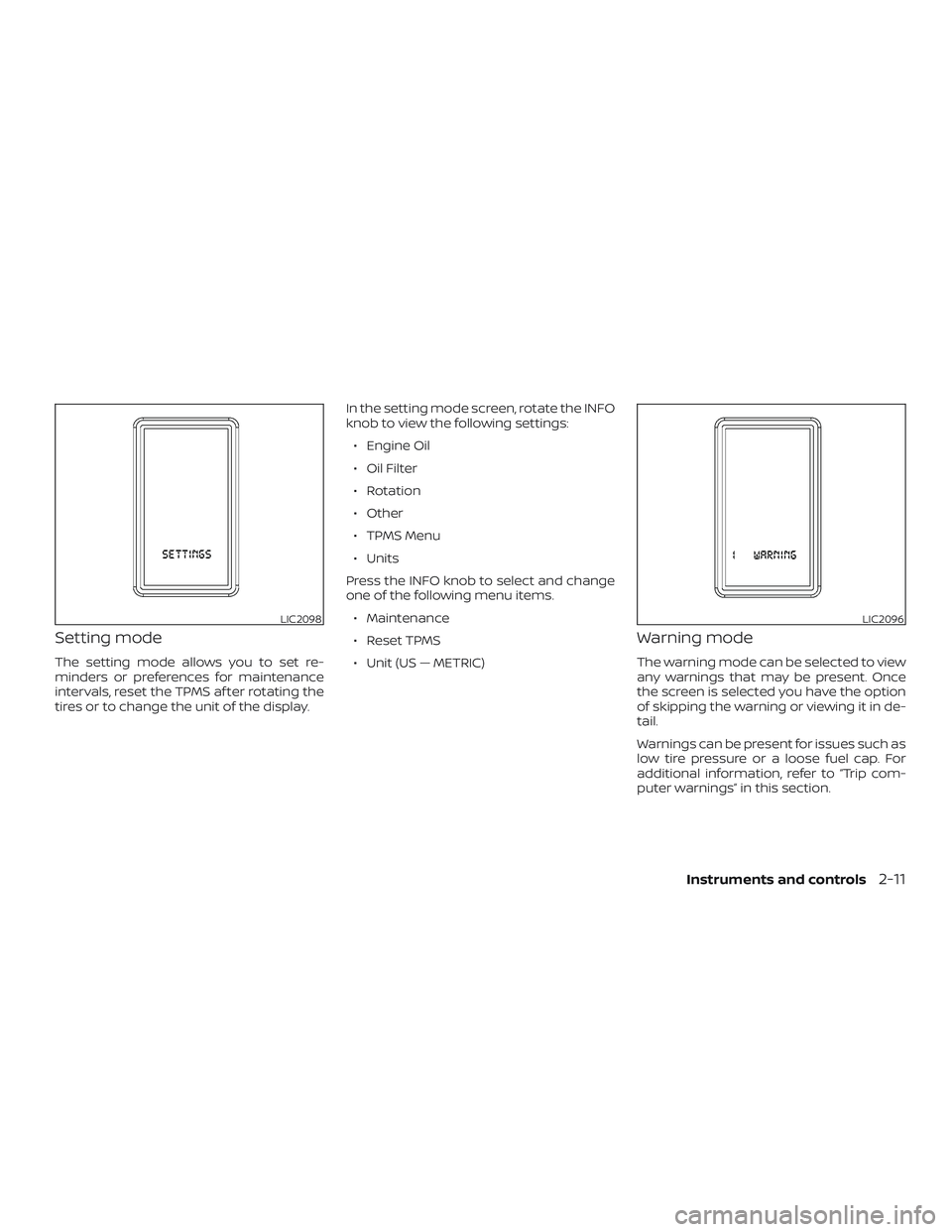
Setting mode
The setting mode allows you to set re-
minders or preferences for maintenance
intervals, reset the TPMS af ter rotating the
tires or to change the unit of the display.In the setting mode screen, rotate the INFO
knob to view the following settings:
∙ Engine Oil
∙ Oil Filter
∙ Rotation
∙ Other
∙ TPMS Menu
∙ Units
Press the INFO knob to select and change
one of the following menu items. ∙ Maintenance
∙ Reset TPMS
∙ Unit (US — METRIC)
Warning mode
The warning mode can be selected to view
any warnings that may be present. Once
the screen is selected you have the option
of skipping the warning or viewing it in de-
tail.
Warnings can be present for issues such as
low tire pressure or a loose fuel cap. For
additional information, refer to “Trip com-
puter warnings” in this section.
LIC2098LIC2096
Instruments and controls2-11
Page 101 of 426
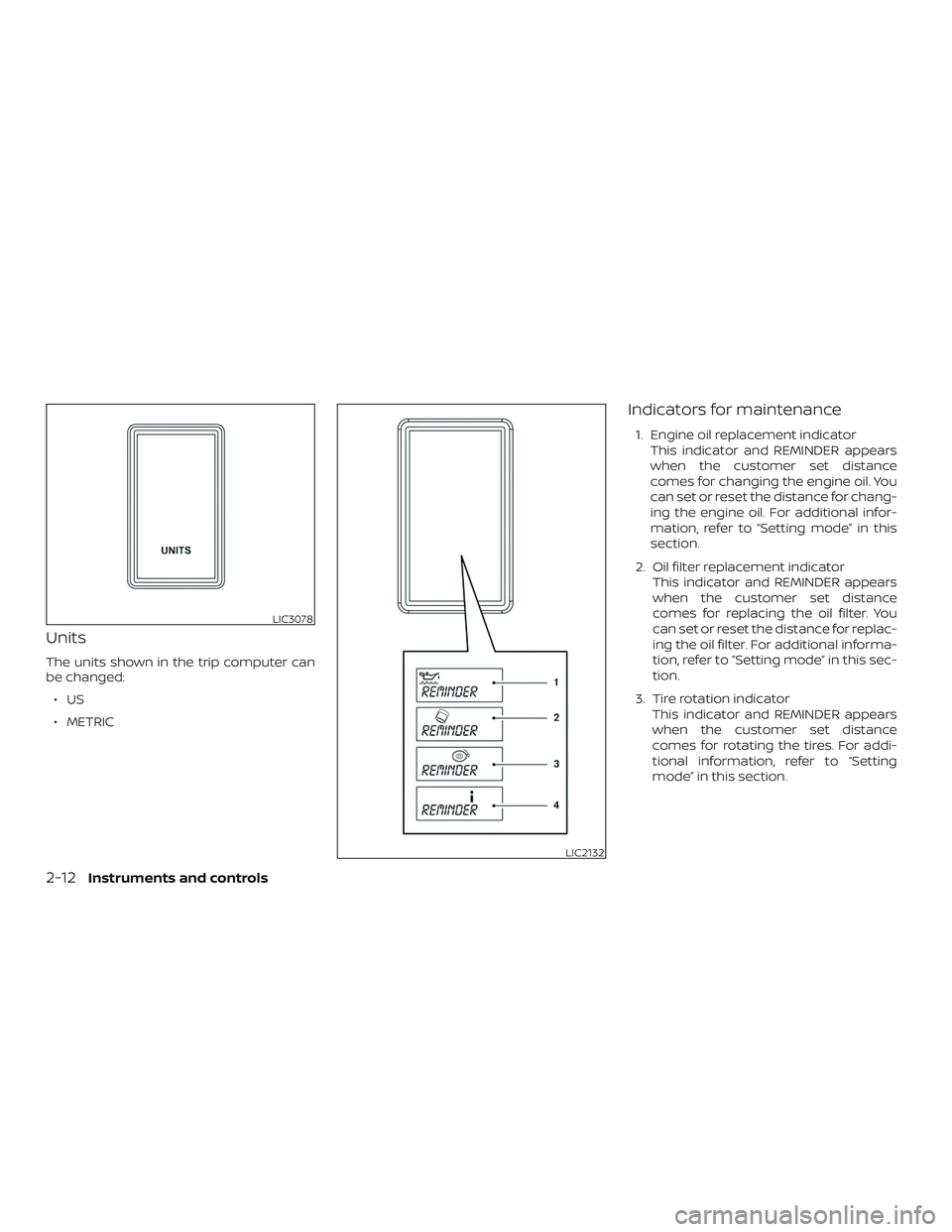
Units
The units shown in the trip computer can
be changed:∙US
∙ METRIC
Indicators for maintenance
1. Engine oil replacement indicator This indicator and REMINDER appears
when the customer set distance
comes for changing the engine oil. You
can set or reset the distance for chang-
ing the engine oil. For additional infor-
mation, refer to “Setting mode” in this
section.
2. Oil filter replacement indicator This indicator and REMINDER appears
when the customer set distance
comes for replacing the oil filter. You
can set or reset the distance for replac-
ing the oil filter. For additional informa-
tion, refer to “Setting mode” in this sec-
tion.
3. Tire rotation indicator This indicator and REMINDER appears
when the customer set distance
comes for rotating the tires. For addi-
tional information, refer to “Setting
mode” in this section.
LIC3078
LIC2132
2-12Instruments and controls
Page 102 of 426
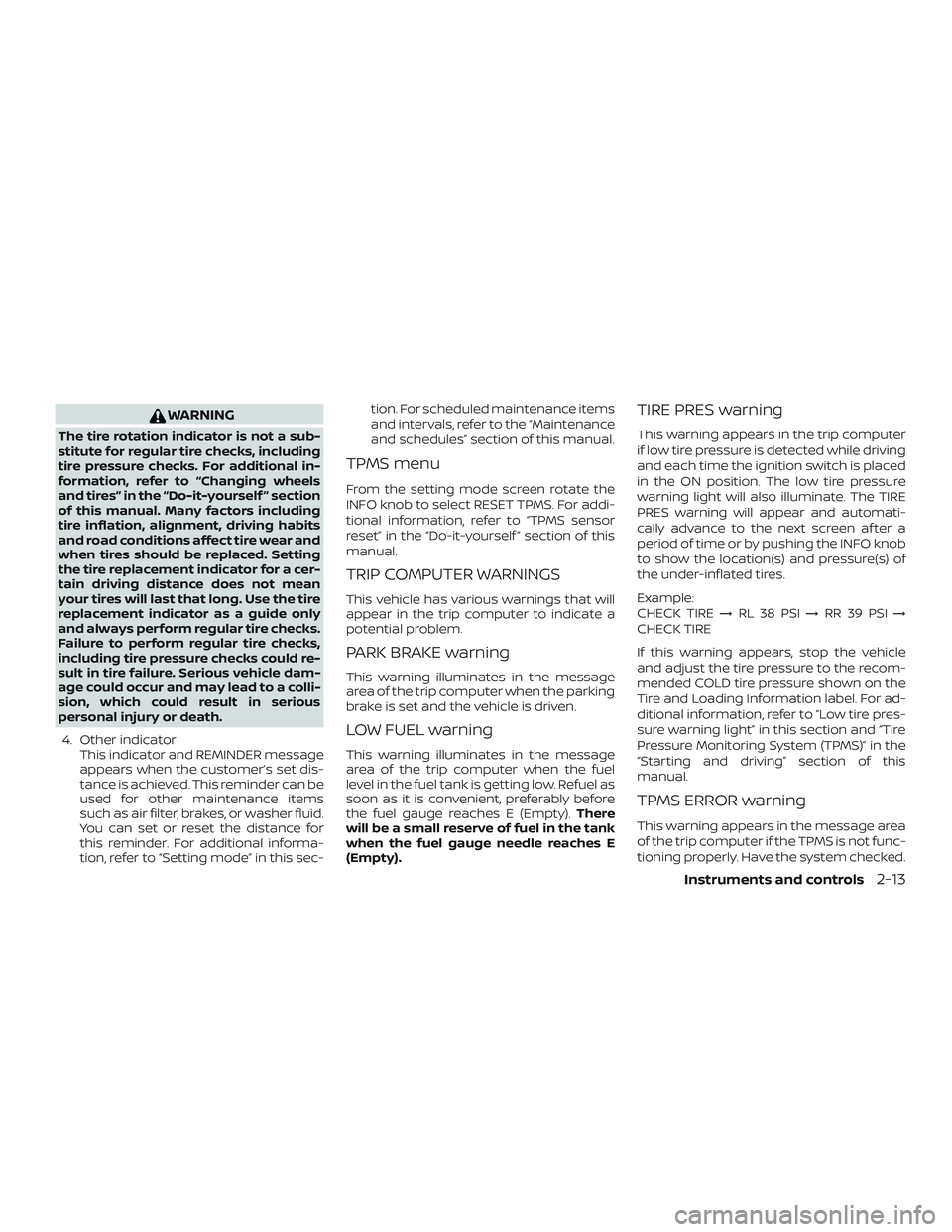
WARNING
The tire rotation indicator is not a sub-
stitute for regular tire checks, including
tire pressure checks. For additional in-
formation, refer to “Changing wheels
and tires” in the “Do-it-yourself ” section
of this manual. Many factors including
tire inflation, alignment, driving habits
and road conditions affect tire wear and
when tires should be replaced. Setting
the tire replacement indicator for a cer-
tain driving distance does not mean
your tires will last that long. Use the tire
replacement indicator as a guide only
and always perform regular tire checks.
Failure to perform regular tire checks,
including tire pressure checks could re-
sult in tire failure. Serious vehicle dam-
age could occur and may lead to a colli-
sion, which could result in serious
personal injury or death.4. Other indicator This indicator and REMINDER message
appears when the customer’s set dis-
tance is achieved. This reminder can be
used for other maintenance items
such as air filter, brakes, or washer fluid.
You can set or reset the distance for
this reminder. For additional informa-
tion, refer to “Setting mode” in this sec- tion. For scheduled maintenance items
and intervals, refer to the “Maintenance
and schedules” section of this manual.
TPMS menu
From the setting mode screen rotate the
INFO knob to select RESET TPMS. For addi-
tional information, refer to “TPMS sensor
reset” in the “Do-it-yourself ” section of this
manual.
TRIP COMPUTER WARNINGS
This vehicle has various warnings that will
appear in the trip computer to indicate a
potential problem.
PARK BRAKE warning
This warning illuminates in the message
area of the trip computer when the parking
brake is set and the vehicle is driven.
LOW FUEL warning
This warning illuminates in the message
area of the trip computer when the fuel
level in the fuel tank is getting low. Refuel as
soon as it is convenient, preferably before
the fuel gauge reaches E (Empty).
There
will be a small reserve of fuel in the tank
when the fuel gauge needle reaches E
(Empty).
TIRE PRES warning
This warning appears in the trip computer
if low tire pressure is detected while driving
and each time the ignition switch is placed
in the ON position. The low tire pressure
warning light will also illuminate. The TIRE
PRES warning will appear and automati-
cally advance to the next screen af ter a
period of time or by pushing the INFO knob
to show the location(s) and pressure(s) of
the under-inflated tires.
Example:
CHECK TIRE →RL 38 PSI →RR 39 PSI →
CHECK TIRE
If this warning appears, stop the vehicle
and adjust the tire pressure to the recom-
mended COLD tire pressure shown on the
Tire and Loading Information label. For ad-
ditional information, refer to “Low tire pres-
sure warning light” in this section and “Tire
Pressure Monitoring System (TPMS)” in the
“Starting and driving” section of this
manual.
TPMS ERROR warning
This warning appears in the message area
of the trip computer if the TPMS is not func-
tioning properly. Have the system checked.
Instruments and controls2-13
Page 415 of 426
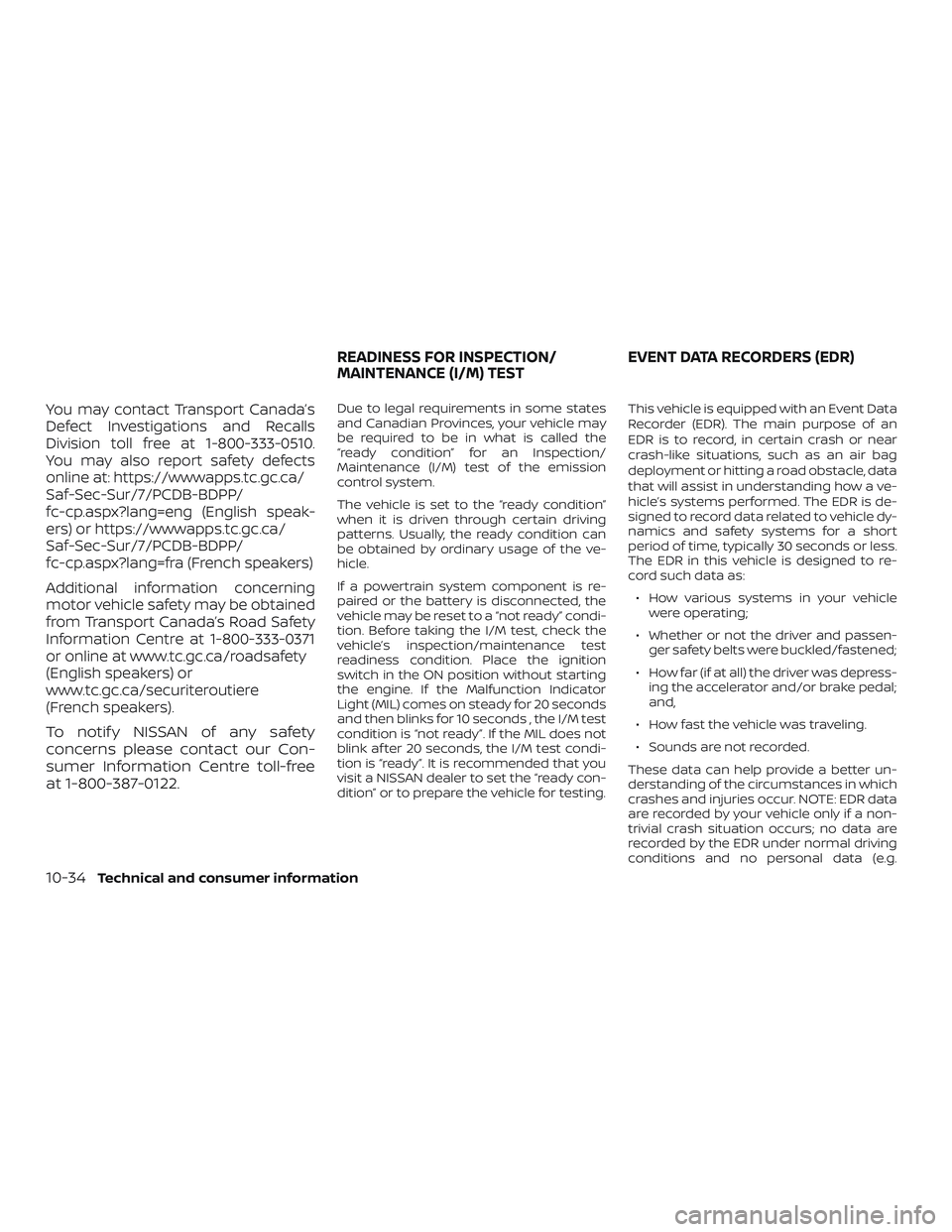
You may contact Transport Canada’s
Defect Investigations and Recalls
Division toll free at 1-800-333-0510.
You may also report safety defects
online at: https://wwwapps.tc.gc.ca/
Saf-Sec-Sur/7/PCDB-BDPP/
fc-cp.aspx?lang=eng (English speak-
ers) or https://wwwapps.tc.gc.ca/
Saf-Sec-Sur/7/PCDB-BDPP/
fc-cp.aspx?lang=fra (French speakers)
Additional information concerning
motor vehicle safety may be obtained
from Transport Canada’s Road Safety
Information Centre at 1-800-333-0371
or online at www.tc.gc.ca/roadsafety
(English speakers) or
www.tc.gc.ca/securiteroutiere
(French speakers).
To notif y NISSAN of any safety
concerns please contact our Con-
sumer Information Centre toll-free
at 1-800-387-0122.
Due to legal requirements in some states
and Canadian Provinces, your vehicle may
be required to be in what is called the
“ready condition” for an Inspection/
Maintenance (I/M) test of the emission
control system.
The vehicle is set to the “ready condition”
when it is driven through certain driving
patterns. Usually, the ready condition can
be obtained by ordinary usage of the ve-
hicle.
If a powertrain system component is re-
paired or the battery is disconnected, the
vehicle may be reset to a “not ready” condi-
tion. Before taking the I/M test, check the
vehicle’s inspection/maintenance test
readiness condition. Place the ignition
switch in the ON position without starting
the engine. If the Malfunction Indicator
Light (MIL) comes on steady for 20 seconds
and then blinks for 10 seconds , the I/M test
condition is “not ready”. If the MIL does not
blink af ter 20 seconds, the I/M test condi-
tion is “ready”. It is recommended that you
visit a NISSAN dealer to set the “ready con-
dition” or to prepare the vehicle for testing.This vehicle is equipped with an Event Data
Recorder (EDR). The main purpose of an
EDR is to record, in certain crash or near
crash-like situations, such as an air bag
deployment or hitting a road obstacle, data
that will assist in understanding how a ve-
hicle’s systems performed. The EDR is de-
signed to record data related to vehicle dy-
namics and safety systems for a short
period of time, typically 30 seconds or less.
The EDR in this vehicle is designed to re-
cord such data as:
∙ How various systems in your vehicle were operating;
∙ Whether or not the driver and passen- ger safety belts were buckled/fastened;
∙ How far (if at all) the driver was depress- ing the accelerator and/or brake pedal;
and,
∙ How fast the vehicle was traveling.
∙ Sounds are not recorded.
These data can help provide a better un-
derstanding of the circumstances in which
crashes and injuries occur. NOTE: EDR data
are recorded by your vehicle only if a non-
trivial crash situation occurs; no data are
recorded by the EDR under normal driving
conditions and no personal data (e.g.
READINESS FOR INSPECTION/
MAINTENANCE (I/M) TEST EVENT DATA RECORDERS (EDR)
10-34Technical and consumer information
Page 422 of 426
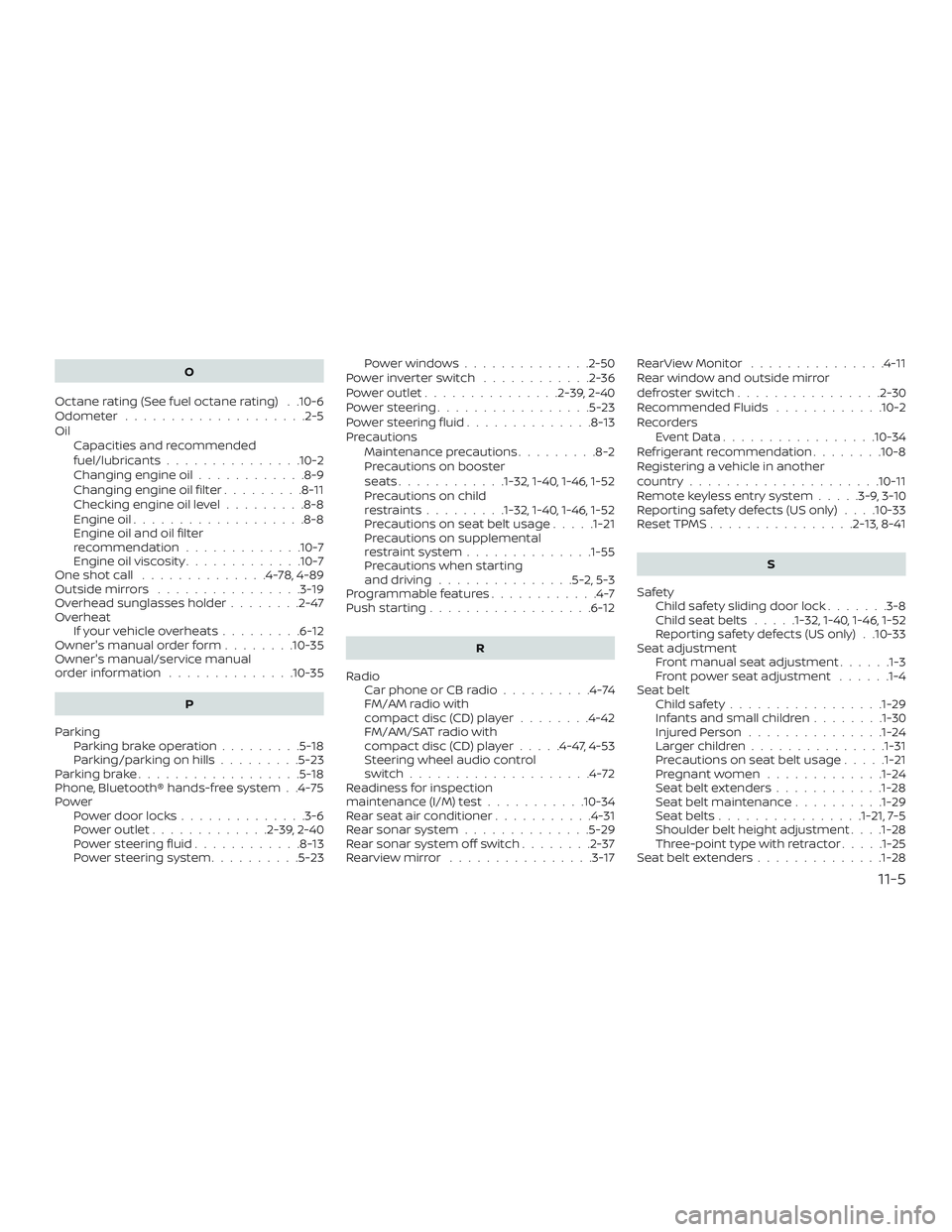
O
Octane rating (See fuel octane rating) . .10-6
Odometer ....................2-5
Oil Capacities and recommended
fuel/lubricants...............10-2
Changing engine oil ............8-9
Changing engine oil filter .........8-11
Checking engine oil level .........8-8
Engine oil ...................8-8
Engine oil and oil filter
recommendation .............10-7
Engine oil viscosity .............10-7
One shot call ..............4-78,4-89
Outsidemirrors ................3-19
Overhead sunglasses holder ........2-47
Overheat Ifyourvehicleoverheats.........6-12
Owner's manual order form ........10-35
Owner's manual/service manual
orderinformation ..............10-35
P
Parking Parking brake operation .........5-18
Parking/parkingonhills.........5-23
Parkingbrake..................5-18
Phone, Bluetooth® hands-free system . .4-75
Power Power door locks ..............3-6
Poweroutlet.............2-39,2-40
Powersteeringfluid............8-13
Power steering system ..........5-23 Powerwindows..............2-50
Powerinverterswitch ............2-36
Poweroutlet...............2-39,2-40
Powersteering.................5-23
Powersteeringfluid..............8-13
Precautions Maintenance precautions .........8-2
Precautions on booster
seats............1-32, 1-40, 1-46, 1-52
Precautions on child
restraints.........1-32, 1-40, 1-46, 1-52
Precautions on seat belt usage .....1-21
Precautions on supplemental
restraint system ..............1-55
Precautions when starting
and driving ...............5-2,5-3
Programmable features ............4-7
Push starting ..................6-12
R
Radio Car phone or CB radio ..........4-74
FM/AM radio with
compact disc (CD) player ........4-42
FM/AM/SAT radio with
compact disc (CD) player .....4-47,4-53
Steering wheel audio control
switch....................4-72
Readiness for inspection
maintenance (I/M) test ...........10-34
Rear seat air conditioner ...........4-31
Rear sonar system ..............5-29
Rear sonar system off switch ........2-37
Rearviewmirror ............... .3-17RearViewMonitor ...............4-11
Rear window and outside mirror
defrosterswitch................2-30
Recommended Fluids
............10-2
Recorders EventData.................10-34
Refrigerant recommendation ........10-8
Registering a vehicle in another
country .....................10-11
Remote keyless entry system .....3-9,3-10
Reporting safety defects (US only) . . . .10-33
Reset TPMS ................2-13,8-41
S
Safety Child safety sliding door lock .......3-8
Childseatbelts .....1-32, 1-40, 1-46, 1-52
Reporting safety defects (US only) . .10-33
Seat adjustment Front manual seat adjustment ......1-3
F
ront power seat adjustment ......1-4
Seat belt Childsafety................ .1-29
Infants and small children ........1-30
InjuredPerson.............. .1-24
Largerchildren.............. .1-31
Precautionsonseatbeltusage.....1-21
Pregnant women .............1-24
Seat belt extenders ............1-28
Seat belt maintenance ..........1-29
Seatbelts................1-21, 7-5
Shoulder belt height adjustment . . . .1-28
Three-pointtypewithretractor.....1-25
Seat belt extenders ..............1-28
11-5